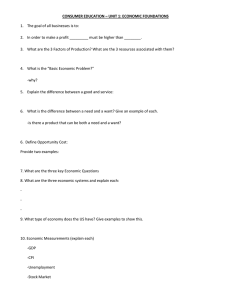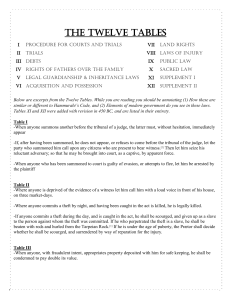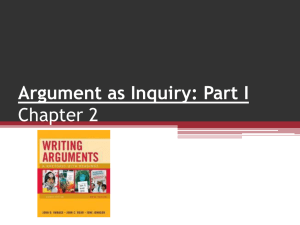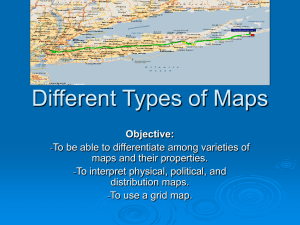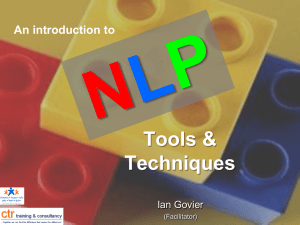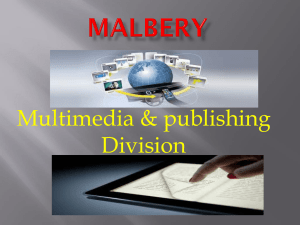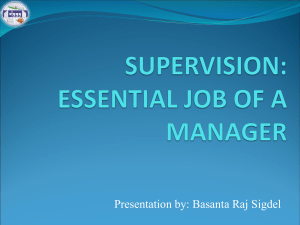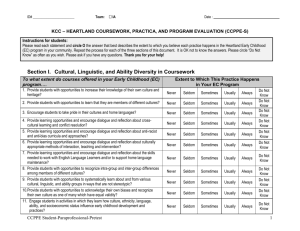Easy Conflict Resolution 1-2
advertisement
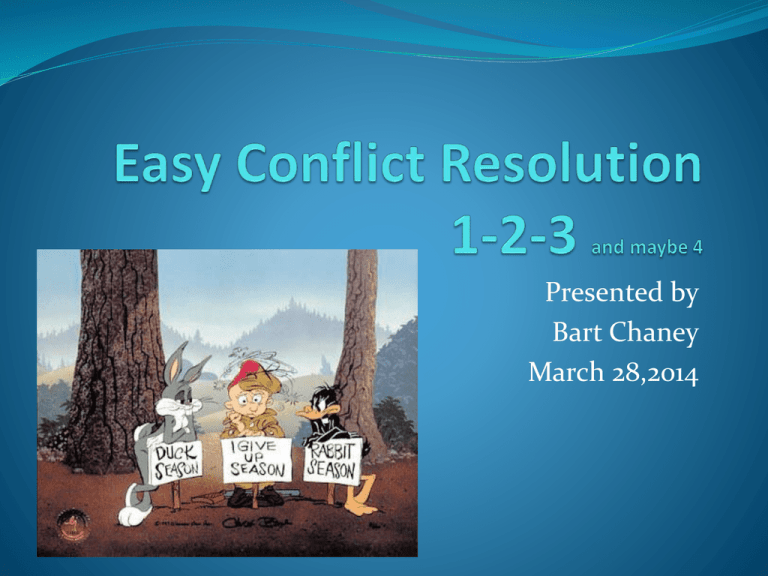
Presented by Bart Chaney March 28,2014 What is Conflict? con·flict verb 1. to come into collision or disagreement; be contradictory, at variance, or in opposition; clash: The account of one eyewitness conflicted with that of the other. My class conflicts with my going to the concert. 2. to fight or contend; do battle. noun 3. a fight, battle, or struggle, especially a prolonged struggle; strife. 4. controversy; quarrel: conflicts between parties. 5. discord of action, feeling, or effect; antagonism or opposition, as of interests or principles: a conflict of ideas. 6. a striking together; collision. 7. incompatibility or interference, as of one idea, desire, event, or activity with another: a conflict in the schedule Why is Conflict Resolution important to me? Personal Happiness Peaceful Coexistence Increased Productivity Continued Employment “The ability to deal with people is as purchasable a commodity as sugar or coffee, and I will pay more for that ability than any other under the sun.” John D. Rockefeller Sources of Conflict When you’re right and the other person just doesn’t realize it. When your wrong and you just don’t realize it. When you are male and they are female. When the other person doesn’t realize it’s all about you. Your supervisor is a big jerk… Real Sources of Conflict 1. 2. 3. 4. 5. 6. 7. 8. Goals are not the same Disagreement Personality Communication issues Unclear/unrealistic expectations Unfairness (real/perceived) Personal issues Your supervisor is a “REAL” big jerk… What about conflict… Is conflict always negative? Using conflict in a positive way… Can promote needed change Can initiate needed communication Can bring more serious issues to light Conflict Resolution Conflict resolution is the process of resolving a dispute or a conflict by meeting at least some of each side's needs and addressing their interests. Conflict Reaction Profile Numbering Scale 1 = Seldom 2 = Sometimes 3 = Most of the time 1=Seldom; 2=Sometimes; 3=Most of the time 1. I can be swayed to someone else’s point of view. 2. I shut down people who I disagree with. 3. I address the issue at hand diplomatically and do not attack the individual. 4. I think that others try to bully their way with me. 5. I express my thoughts and beliefs tactfully when they differ from those just expressed. 6. Rather than offer my opinion when I disagree with someone, I keep it to myself. 7. I listen to other people’s points of view with an open mind. 1=Seldom; 2=Sometimes; 3=Most of the time 8. I let my emotions get the best of me. 9. I raise my voice to make my point. 10. I tend to belittle other people when making my point. 11. I look for ways to negotiate and compromise with others. 12. I have been told I am too pushy. 13. I make sure I have my opinion heard in any controversy. 14. I think conflict in meetings is necessary. 15. I am the most vocal in meetings when trying to get my point across. Conflict Reaction Profile Score Scoring: Add the total from questions 1,2,4,6,8,9,10,12,13,14,15 Subtract the sum of the score from questions 3,5,7,11 What does the score mean? 1-4: “Passive” You may be such a pushover that you allow difficult people to walk all over you. You will benefit from learning to stand up for your ideas and opinions in a diplomatic and tactful way. 5-10: “Assertive” You are professionally assertive when dealing with people, particularly difficult people. Continue to be open to listening to different points of view, and express your ideas and opinions appropriately. 11+ “Aggressive” You may be so combative that people might avoid interacting with you. You will benefit from learning to listen and express your opinions more effectively. 5 Conflict Management Strategies Forcing – using formal authority or other power you possess to satisfy your concerns without regard to the concerns of the party that you are in conflict with. Accommodating – allowing the other party to satisfy their concerns while neglecting your own. Avoiding – not paying attention to the conflict and not taking any action to resolve it. Compromising – attempting to resolve a conflict by identifying a solution that is partially satisfactory to both parties, but completely satisfactory to neither. Collaborating – cooperating with the other party to understand their concerns and expressing your own concerns in an effort to find a mutually and completely satisfactory solution. Matching Strategies to Situations When would “Forcing” be a good strategy? -Company policy -Law -Ethics -In an emergency when time is critical Matching Strategies to Situations When would “Accommodating” be a good strategy -When preserving or building a relationship is more important -When it is not a significant cost to you to do so -To restore harmony during a tense moment or after a disagreement. -To satisfy a complaint when in the process of providing customer service Matching Strategies to Situations When would “Avoiding” be a good strategy? -When the issue is trivial and other issues are more important -When there is no opportunity to constructively address the concern -To buy time to give angry people time to cool down -To refrain from making a rushed decision and have more time to gather information or support Matching Strategies to Situations When would “Compromising” be a good Strategy? -Dividing a work load -Sharing a cost -Temporary solution, till you have more time Matching Strategies to Situations When would “Collaborating” be a good strategy? -When there is little time pressure -When the issue is of high importance involving priorities, principles or values. -When maintaining a close, mutually supportive relationship with the other party is important. -Relative power - how much authority you have compared to how much authority the other party has. Keys to Successful Conflict Resolution 1. 2. 3. 4. 5. 6. One trait to remember at all times during conflict: ATTITUDE/PROFESSIONALISM Listen Discuss Listen Review of appropriate rules/policies if applicable Listen STABEN Tool to Resolve Conflict S = Source: Identify the source of the conflict T = Time and Place: Best time and place to discuss the conflict or concern A = Amicable: Start your conversation with a positive about the person B = Behavior: State the problem behavior concisely E = Emotion: Because of your “behavior” I feel… N = Need: What you need to make it right How to Avert Conflict First seek to understand-be sure you know the other party’s concerns and priorities Then be sure they understand where you stand Be open, don’t keep a hidden agenda Know your role – employee, co-worker, supervisor, other Align your goals Get to know those you are working with (sense of humor) Always maintain an attitude of respect Comic Conflict Relief https://www.youtube.com/watch?v=RzToNo7A-94 Enjoy a conflict day…
